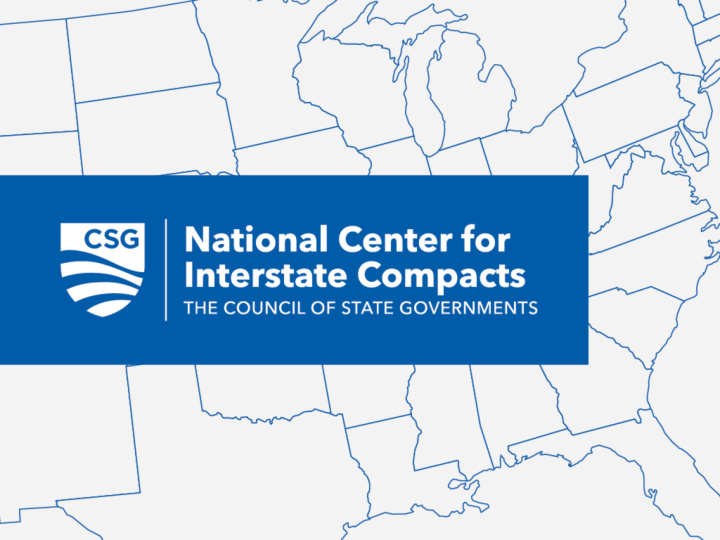



WHAT IS AN INTERSTATE COMPACT? 2
WHAT IS AN INTERSTATE COMPACT? Simple, versatile and proven tool Effective means of cooperatively addressing common problems Allows states to respond to national priorities with one voice Retains collective state sovereignty over issues belonging to the states 3
THREE PRIMARY USES 1. Used to resolve boundary disputes. 2. Used to manage shared natural resources. 3. Used to create administrative agencies which have jurisdiction over a wide variety of state concerns: State transportation Taxation Environmental matters Regulation Education Corrections Public safety Occupational Licensure 4
EVOLVING COMPACT LANDSCAPE Threat of a federally mandated solution Advances in technology Increasingly mobile world Distrust of federal government Proven track record 5
CONGRESSIONAL CONSENT Compacts between States are authorized under Art. I, Sec. 10, Cl. 3 of the U. S. Constitution: No State shall, without the Consent of Congress . . . enter into any Agreement Compact with another State . . . “ U.S. Supreme Court holds, in effect, that “any” doesn’t mean “all” and consent isn’t required unless the compact infringes on the federal supremacy. [See U.S. Steel Corp. v. Multi-State Tax Commission, 434 U.S. 452 (1978)] 6
COMPACTS TODAY Approximately 215 active compacts Precedence for international participation On average states are members of about 25 compacts Port Authority of NY & NJ (1922) signaled a new era in regulatory compacts 8
BENEFITS OF THE INTERSTATE COMPACT 9
BENEFITS OF INTERSTATE COMPACTS Effectiveness and efficiency 1. • Economies of scale 2. Flexibility and autonomy compared to national policy • “One size does not fit all” 3. Dispute resolution among the states 4. State and federal partnership 5. Cooperative behaviors leading to “win-win” situations 10
BENEFITS OF LICENSURE COMPACTS 1. Agreement on Uniform Licensure Requirements 2. A data system adequate to allow electronic processing of interstate licensure 3. Disciplinary issues related to interstate licensure 4. FBI Fingerprint Based Criminal Background Checks 5. Compact governance issues: I. Legal status of interstate compact governing agency II. Rulemaking and other authority 11
LICENSURE COMPACTS: ADDITIONAL BENEFITS National data & information sharing systems Uniform compact language and rules Proven governance structures National interface with external stakeholders & national organizations Coordination with other interstate compacts National office and staff (if necessary) 12
DEVELOPING AN INTERSTATE COMPACT 13
INTERSTATE COMPACT GOVERNANCE 15
COMPACT COMMISSION Forms when the threshold of jurisdictions pass compact legislation Is typically a quasi-governmental entity Supra-state, sub-federal nature May hire staff and determine physical presence 16
INTERSTATE COMPACTS TYPICAL GOVERNANCE STRUCTURE The commission is comprised of voting representatives from each member state and is responsible for key decisions with respect to the compact. The commission can form committees, including an executive committee that is responsible for making day-to-day decisions. Compact commissions are frequently granted the authority to hire staff, which is responsible for implementing the policies and procedures established by the commission Commissions serve agencies of the member states and are tasked with acting on their behalf and not on the behalf of particular groups or organizations. 18
OCCUPATIONAL LICENSURE COMPACTS Nurse Licensure Compact – 25 states (expired) Enhanced Nurse Licensure Compact – 34 states (25) APRN Compact – 3 states (10) EMS Licensure Compact (REPLICA) – 18 states (10) Medical Licensure Compact – 29 states (7) Physical Therapy Compact – 25 states (10) PsyPact – 12 states (7 state threshold) ASLP-IC – (10 states) 19
WHY HEALTH CARE LICENSE RECIPROCITY? Mobile society (patients and practitioners) Technological advancements Rising population Deficit of health care professionals, especially serving rural areas Practical advancement for current and future generations of practitioners 20
HEALTH CARE LICENSE RECIPROCITY SIMILAR PARAMETERS Increase public access to health care services Enhance the states’ ability to protect the public’s health and safety Support of spouses of relocating military members Enhance the exchange of licensure, investigatory, and disciplinary information between member states 21
HEALTH CARE LICENSURE COMPACTS F.A.Q. 22
HEALTH CARE LICENSURE COMPACTS F.A.Q. Myth 1: Interstate compacts are a takeover of state licensing 23
HEALTH CARE LICENSE RECIPROCITY Compacts are a State-based approach to multi-state licensure that uses a vehicle for interstate collaboration that is provided for in the U.S. Constitution. State licensure processes remain in place Licensees voluntarily become part of a Compact State practice acts are not impacted 25
HEALTH CARE LICENSURE COMPACTS F.A.Q. Myth 2: Interstate compacts are owned or controlled by an outside organization. 26
HEALTH CARE LICENSURE COMPACTS F.A.Q. M YTH 3: Commission rules and bylaws thwart state sovereignty. 29
HEALTH CARE LICENSE RECIPROCITY Rules do not change the state practice act Rules are specific to the implementation of the Compact’s extension of professional licensure across state lines Each Member State has a seat at the table to craft rules, bylaws, and other administrative functions of the compact 31
CONTACT INFORMATION Rick Masters Special Counsel, National Center for Interstate Compacts rmasters@csg.org Visit CSG’s National Center for Interstate Compacts online at: www.csg.org/ncic 32
Recommend
More recommend